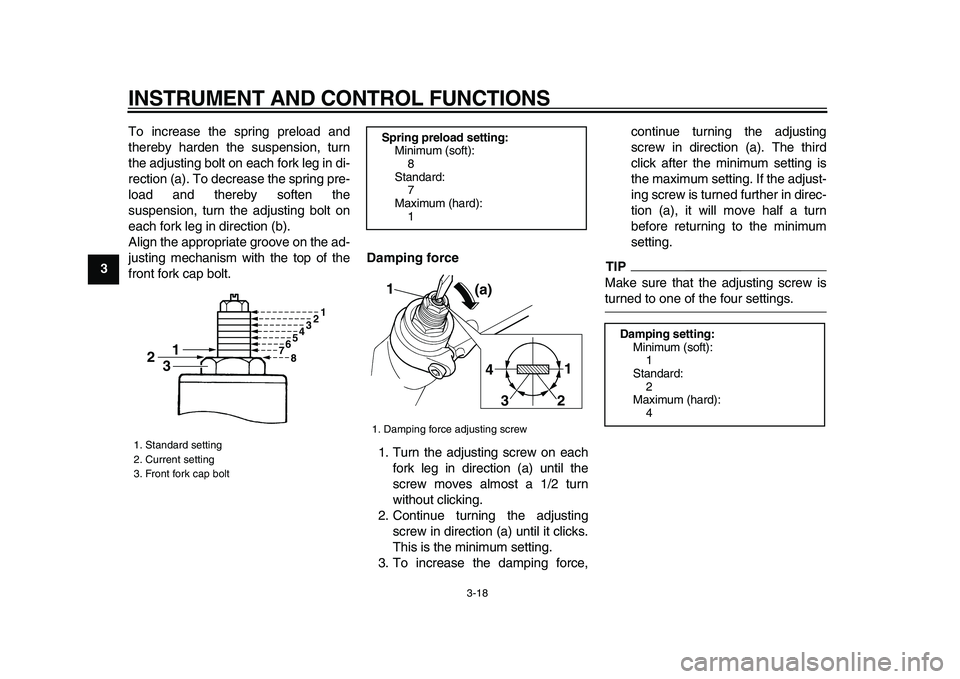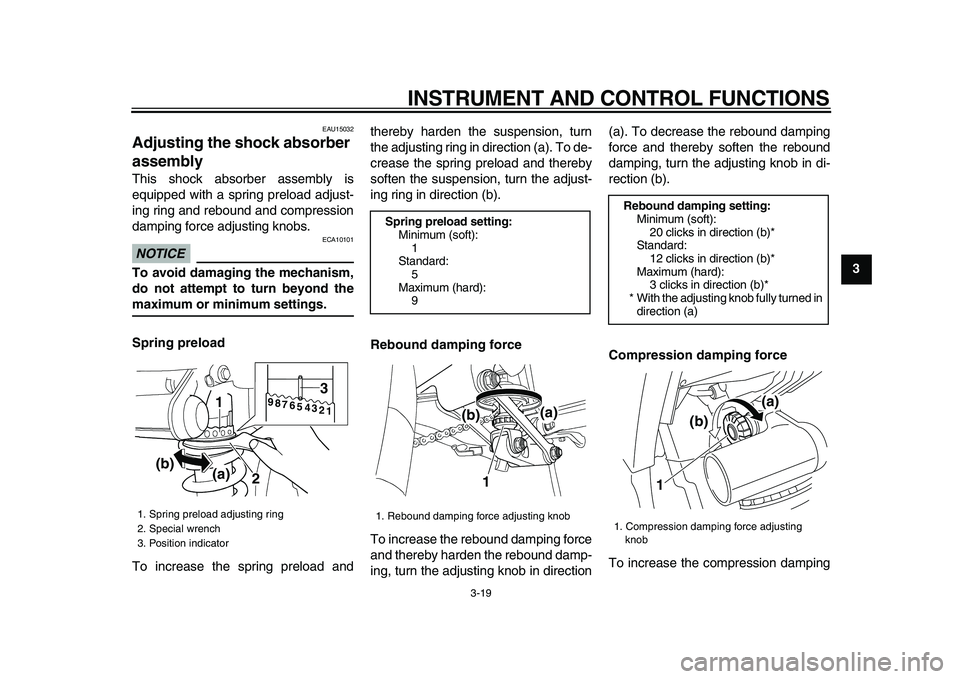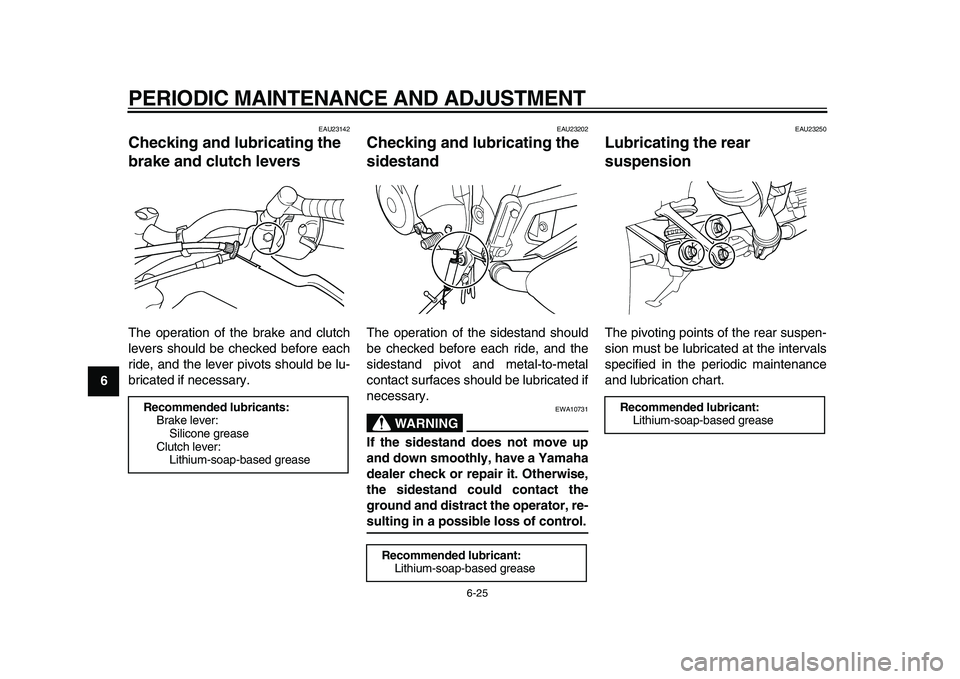2009 YAMAHA TDM 900 suspension
[x] Cancel search: suspensionPage 6 of 94

TABLE OF CONTENTS
SAFETY INFORMATION
...................1-1
DESCRIPTION
...................................2-1
Left view ...........................................2-1
Right view .........................................2-3
Controls and instruments..................2-5
INSTRUMENT AND CONTROL
FUNCTIONS
........................................3-1
Immobilizer system ..........................3-1
Main switch/steering lock .................3-2
Indicator and warning lights .............3-4
Tachometer unit ...............................3-6
Coolant temperature gauge .............3-7
Multi-function display .......................3-7
Anti-theft alarm (optional) ................3-9
Handlebar switches .........................3-9
Clutch lever ....................................3-10
Shift pedal ......................................3-11
Brake lever ....................................3-11
Brake pedal ...................................3-12
ABS (for ABS models) ...................3-12
Fuel tank cap .................................3-13
Fuel ................................................3-14
Fuel tank breather hose .................3-15
Catalytic converters .......................3-15
Seat ...............................................3-16
Storage compartment ....................3-17
Adjusting the front fork ...................3-17
Adjusting the shock absorber
assembly ....................................3-19Luggage strap holders .................. 3-20
Sidestand ...................................... 3-21
Ignition circuit cut-off system ......... 3-21
FOR YOUR SAFETY –
PRE-OPERATION CHECKS
.............. 4-1
OPERATION AND IMPORTANT
RIDING POINTS
.................................. 5-1
Starting the engine .......................... 5-1
Shifting ............................................ 5-2
Tips for reducing fuel consumption . 5-3
Engine break-in ............................... 5-3
Parking ............................................ 5-4
PERIODIC MAINTENANCE AND
ADJUSTMENT
.................................... 6-1
Owner’s tool kit ................................ 6-1
Periodic maintenance and
lubrication chart ........................... 6-2
Removing and installing cowlings
and panels ................................... 6-6
Checking the spark plugs ................ 6-7
Engine oil and oil filter element ....... 6-8
Coolant .......................................... 6-11
Replacing the air filter element ...... 6-12
Adjusting the engine idling
speed ......................................... 6-14
Checking the throttle cable free
play ............................................ 6-15
Valve clearance ............................. 6-15Tires .............................................. 6-15
Cast wheels .................................. 6-18
Adjusting the clutch lever free
play ............................................ 6-18
Adjusting the rear brake light
switch ......................................... 6-19
Checking the front and rear
brake pads ................................. 6-19
Checking the brake fluid level ....... 6-20
Changing the brake fluid ............... 6-21
Drive chain slack ........................... 6-22
Cleaning and lubricating the
drive chain ................................. 6-23
Checking and lubricating the
cables ........................................ 6-24
Checking and lubricating the
throttle grip and cable ................ 6-24
Checking and lubricating the
brake and shift pedals ............... 6-24
Checking and lubricating the
brake and clutch levers .............. 6-25
Checking and lubricating the
sidestand ................................... 6-25
Lubricating the rear suspension .... 6-25
Checking the front fork .................. 6-26
Checking the steering ................... 6-26
Checking the wheel bearings ........ 6-27
Battery ........................................... 6-27
Replacing the fuses ...................... 6-28
Replacing a headlight bulb ........... 6-30
Page 10 of 94

SAFETY INFORMATION
1-3
1
engine exhaust can be drawn into
a building through openings such
as windows and doors.
Loading
Adding accessories or cargo to your
motorcycle can adversely affect stabili-
ty and handling if the weight distribution
of the motorcycle is changed. To avoid
the possibility of an accident, use ex-
treme caution when adding cargo or
accessories to your motorcycle. Use
extra care when riding a motorcycle
that has added cargo or accessories.
Here, along with the information about
accessories below, are some general
guidelines to follow if loading cargo to
your motorcycle:
The total weight of the operator, pas-
senger, accessories and cargo must
not exceed the maximum load limit.
Operation of an overloaded vehicle
could cause an accident.
When loading within this weight limit,keep the following in mind:
●
Cargo and accessory weight
should be kept as low and close to
the motorcycle as possible. Se-
curely pack your heaviest items as
close to the center of the vehicle as
possible and make sure to distrib-
ute the weight as evenly as possi-
ble on both sides of the motorcycle
to minimize imbalance or instabili-
ty.
●
Shifting weights can create a sud-
den imbalance. Make sure that ac-
cessories and cargo are securely
attached to the motorcycle before
riding. Check accessory mounts
and cargo restraints frequently.
●
Properly adjust the suspension
for your load (suspension-ad-
justable models only), and
check the condition and pres-
sure of your tires.
●
Never attach any large or heavy
items to the handlebar, front
fork, or front fender. These
items, including such cargo as
sleeping bags, duffel bags, or
tents, can create unstable han-dling or a slow steering re-
sponse.
●
This vehicle is not designed to
pull a trailer or to be attached to
a sidecar.
Genuine Yamaha Accessories
Choosing accessories for your vehicle
is an important decision. Genuine
Yamaha accessories, which are avail-
able only from a Yamaha dealer, have
been designed, tested, and approved
by Yamaha for use on your vehicle.
Many companies with no connection to
Yamaha manufacture parts and acces-
sories or offer other modifications for
Yamaha vehicles. Yamaha is not in a
position to test the products that these
aftermarket companies produce.
Therefore, Yamaha can neither en-
dorse nor recommend the use of ac-
cessories not sold by Yamaha or
modifications not specifically recom-
mended by Yamaha, even if sold and
installed by a Yamaha dealer.
Maximum load:
TDM900 201 kg (443 lb)
TDM900A 198 kg (437 lb)
Page 11 of 94

SAFETY INFORMATION
1-4
1
Aftermarket Parts, Accessories,
and Modifications
While you may find aftermarket prod-
ucts similar in design and quality to
genuine Yamaha accessories, recog-
nize that some aftermarket accessories
or modifications are not suitable be-
cause of potential safety hazards to you
or others. Installing aftermarket prod-
ucts or having other modifications per-
formed to your vehicle that change any
of the vehicle’s design or operation
characteristics can put you and others
at greater risk of serious injury or death.
You are responsible for injuries related
to changes in the vehicle.
Keep the following guidelines in mind,
as well as those provided under “Load-
ing” when mounting accessories.
●
Never install accessories or carry
cargo that would impair the perfor-
mance of your motorcycle. Care-
fully inspect the accessory before
using it to make sure that it does
not in any way reduce ground
clearance or cornering clearance,
limit suspension travel, steering
travel or control operation, or ob-scure lights or reflectors.
●
Accessories fitted to the handle-
bar or the front fork area can
create instability due to improper
weight distribution or aerody-
namic changes. If accessories
are added to the handlebar or
front fork area, they must be as
lightweight as possible and
should be kept to a minimum.
●
Bulky or large accessories may
seriously affect the stability of
the motorcycle due to aerody-
namic effects. Wind may at-
tempt to lift the motorcycle, or
the motorcycle may become un-
stable in cross winds. These ac-
cessories may also cause
instability when passing or being
passed by large vehicles.
●
Certain accessories can dis-
place the operator from his or
her normal riding position. This
improper position limits the free-
dom of movement of the opera-
tor and may limit control ability,
therefore, such accessories are
not recommended.
●
Use caution when adding electri-
cal accessories. If electrical acces-
sories exceed the capacity of the
motorcycle’s electrical system, an
electric failure could result, which
could cause a dangerous loss of
lights or engine power.
Aftermarket Tires and Rims
The tires and rims that came with your
motorcycle were designed to match the
performance capabilities and to provide
the best combination of handling, brak-
ing, and comfort. Other tires, rims, siz-
es, and combinations may not be
appropriate. Refer to page 6-15 for tire
specifications and more information on
replacing your tires.
Page 34 of 94

INSTRUMENT AND CONTROL FUNCTIONS
3-18
1
2
3
4
5
6
7
8
9
To increase the spring preload and
thereby harden the suspension, turn
the adjusting bolt on each fork leg in di-
rection (a). To decrease the spring pre-
load and thereby soften the
suspension, turn the adjusting bolt on
each fork leg in direction (b).
Align the appropriate groove on the ad-
justing mechanism with the top of the
front fork cap bolt.
Damping force
1. Turn the adjusting screw on each
fork leg in direction (a) until the
screw moves almost a 1/2 turn
without clicking.
2. Continue turning the adjusting
screw in direction (a) until it clicks.
This is the minimum setting.
3. To increase the damping force,continue turning the adjusting
screw in direction (a). The third
click after the minimum setting is
the maximum setting. If the adjust-
ing screw is turned further in direc-
tion (a), it will move half a turn
before returning to the minimum
setting.
TIP
Make sure that the adjusting screw is
turned to one of the four settings.
1. Standard setting
2. Current setting
3. Front fork cap bolt
2
31
7654321
8
Spring preload setting:
Minimum (soft):
8
Standard:
7
Maximum (hard):
1
1. Damping force adjusting screw
(a) 1
1
2
3 4
Damping setting:
Minimum (soft):
1
Standard:
2
Maximum (hard):
4
Page 35 of 94

INSTRUMENT AND CONTROL FUNCTIONS
3-19
2
34
5
6
7
8
9
EAU15032
Adjusting the shock absorber
assembly
This shock absorber assembly is
equipped with a spring preload adjust-
ing ring and rebound and compression
damping force adjusting knobs.
NOTICE
ECA10101
To avoid damaging the mechanism,
do not attempt to turn beyond the
maximum or minimum settings.
Spring preload
To increase the spring preload andthereby harden the suspension, turn
the adjusting ring in direction (a). To de-
crease the spring preload and thereby
soften the suspension, turn the adjust-
ing ring in direction (b).
Rebound damping force
To increase the rebound damping force
and thereby harden the rebound damp-
ing, turn the adjusting knob in direction(a). To decrease the rebound damping
force and thereby soften the rebound
damping, turn the adjusting knob in di-
rection (b).
Compression damping force
To increase the compression damping
1. Spring preload adjusting ring
2. Special wrench
3. Position indicator
(a) (b)3
1
2
1 2 3 4 5 6 7 8 9
Spring preload setting:
Minimum (soft):
1
Standard:
5
Maximum (hard):
9
1. Rebound damping force adjusting knob1
(a)
(b)
Rebound damping setting:
Minimum (soft):
20 clicks in direction (b)*
Standard:
12 clicks in direction (b)*
Maximum (hard):
3 clicks in direction (b)*
*With the adjusting knob fully turned in
direction (a)
1. Compression damping force adjusting
knob
1
(a)
(b)
Page 49 of 94

PERIODIC MAINTENANCE AND ADJUSTMENT
6-4
2
3
4
5
67
8
9
19
Shift pedal pivot
shaft
●
Lubricate with lithium-soap-based
grease.
√√√√√
20
Sidestand
●
Check operation.
●
Lubricate.
√√√√√
21
*
Sidestand switch
●
Check operation.
√√√√√√
22
*
Front fork
●
Check operation and for oil
leakage.
√√√√
23
*
Shock absorber
assembly
●
Check operation and shock
absorber for oil leakage.
√√√√
24
*
Rear suspension
relay arm and
connecting arm
pivoting points
●
Check operation.
√√√√
●
Lubricate with lithium-soap-based
grease.
√√
25
*
Fuel injection
●
Adjust engine idling speed and
synchronization.
√√√√√√
26
Engine oil
●
Change.
●
Check oil level and vehicle for oil
leakage.
√√√√√√
27
Engine oil filter
element
●
Replace.
√√√
28
*
Cooling system
●
Check coolant level and vehicle
for coolant leakage.
√√√√√
●
Change. Every 3 years
29
*
Front and rear brake
switches
●
Check operation.
√√√√√√
30
Moving parts and
cables
●
Lubricate.
√√√√√
NO. ITEM CHECK OR MAINTENANCE JOBODOMETER READING
ANNUAL
CHECK 1000 km
(600 mi)10000 km
(6000 mi)20000 km
(12000 mi)30000 km
(18000 mi)40000 km
(24000 mi)
Page 70 of 94

PERIODIC MAINTENANCE AND ADJUSTMENT
6-25
1
2
3
4
5
6
7
8
9
EAU23142
Checking and lubricating the
brake and clutch levers
The operation of the brake and clutch
levers should be checked before each
ride, and the lever pivots should be lu-
bricated if necessary.
EAU23202
Checking and lubricating the
sidestand
The operation of the sidestand should
be checked before each ride, and the
sidestand pivot and metal-to-metal
contact surfaces should be lubricated if
necessary.
WARNING
EWA10731
If the sidestand does not move up
and down smoothly, have a Yamaha
dealer check or repair it. Otherwise,
the sidestand could contact the
ground and distract the operator, re-
sulting in a possible loss of control.
EAU23250
Lubricating the rear
suspension
The pivoting points of the rear suspen-
sion must be lubricated at the intervals
specified in the periodic maintenance
and lubrication chart.
Recommended lubricants:
Brake lever:
Silicone grease
Clutch lever:
Lithium-soap-based grease
Recommended lubricant:
Lithium-soap-based grease
Recommended lubricant:
Lithium-soap-based grease
Page 86 of 94

SPECIFICATIONS
8-2
1
2
3
4
5
6
7
8
9
Transmission type:
Constant mesh 6-speed
Operation:
Left foot operation
Gear ratio:
1st:
33/12 (2.750)
2nd:
37/19 (1.947)
3rd:
34/22 (1.545)
4th:
31/25 (1.240)
5th:
26/25 (1.040)
6th:
24/26 (0.923)
Chassis:
Frame type:
Diamond
Caster angle:
25.50 °
Trail:
114.0 mm (4.49 in)
Front tire:
Type:
Tubeless
Size:
120/70 ZR18M/C (59W)
Manufacturer/model:
TDM900 METZELER/MEZ4 FRONT
TDM900A DUNLOP/D220FSTJ
Manufacturer/model:
TDM900 DUNLOP/D220FSTJ
Rear tire:
Type:
Tubeless
Size:
160/60 ZR17M/C (69W)
Manufacturer/model:
TDM900 METZELER/MEZ4
TDM900A DUNLOP/D220STJ
Manufacturer/model:
TDM900 DUNLOP/D220STJ
Loading:
Maximum load:
TDM900 201 kg (443 lb)
TDM900A 198 kg (437 lb)
*(Total weight of rider, passenger, cargo
and accessories)
Tire air pressure (measured on cold
tires):
Loading condition:
0–90 kg (0–198 lb)
Front:
225 kPa (2.25 kgf/cm2, 33 psi)
Rear:
250 kPa (2.50 kgf/cm2, 36 psi)
Loading condition:
TDM900 90–201 kg (198–443 lb)
TDM900A 90–198 kg (198–437 lb)
Front:
225 kPa (2.25 kgf/cm
2
, 33 psi)
Rear:
290 kPa (2.90 kgf/cm
2
, 42 psi)
High-speed riding:
Front:
225 kPa (2.25 kgf/cm 2
, 33 psi)Rear:
250 kPa (2.50 kgf/cm
2
, 36 psi)
Front wheel:
Wheel type:
Cast wheel
Rim size:
18M/C x MT3.50
Rear wheel:
Wheel type:
Cast wheel
Rim size:
17M/C x MT5.00
Front brake:
Type:
Dual disc brake
Operation:
Right hand operation
Recommended fluid:
DOT 4
Rear brake:
Type:
Single disc brake
Operation:
Right foot operation
Recommended fluid:
DOT 4
Front suspension:
Type:
Telescopic fork